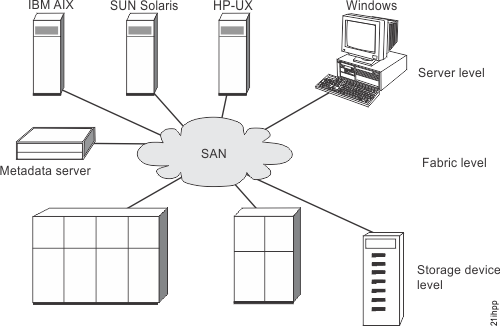Virtualization is a concept that applies to many areas of the information technology industry. A type of virtualization, symmetric virtualization, is optional when Lenovo Storage V7000 is used as an external storage system.
For data storage, virtualization includes the creation of a pool of storage that contains several disk systems. These systems can be supplied from various vendors. The pool can be split into volumes that are visible to the host systems that use them. Therefore, volumes can use mixed back-end storage and provide a common way to manage a storage area network (SAN).
- At the server level
- Manages volumes on the operating systems servers. An increase in the amount of logical storage over physical storage is suitable for environments that do not have storage networks.
- At the storage device level
- Uses RAID to create disk systems. This type of virtualization can range from simple RAID controllers to advanced volume management such as that provided by the IBM® DS8000®. The Virtual Tape Server (VTS) is another example of virtualization at the device level.
- At the fabric level
- Enables storage pools to be independent of the servers and the physical components that make up the storage pools. One management interface can be used to manage different storage systems without affecting the servers. Lenovo Storage V7000 performs virtualization at the fabric level.
- At the file system level
- Provides the highest benefit because data is shared, allocated, and protected at the data level rather than the volume level.
Virtualization is a radical departure from traditional storage management. In traditional storage management, storage is attached directly to a host system, which controls storage management. SANs introduced the principle of networks of storage, but storage is still primarily created and maintained at the RAID system level. Multiple RAID controllers of different types require knowledge of, and software that is specific to, the given hardware. Virtualization provides a central point of control for disk creation and maintenance.
One problem area that virtualization addresses is unused capacity. Before virtualization, individual host systems each had their own storage, which wasted unused storage capacity. Using virtualization, storage is pooled so that jobs from any attached system that need large amounts of storage capacity can use it as needed. Virtualization makes it easier to regulate the amount of available storage without having to use host system resources or to turn storage devices off and on to add or remove capacity. Virtualization also provides the capability to move storage between storage systems transparently to host systems.
Types of virtualization
- Asymmetric
- A virtualization engine is outside the data path and generate a metadata style service. Lenovo Storage V7000 does not use asymmetric virtualization.
- Symmetric
- A virtualization engine sits in the data path and presents disks to the hosts, but hides the physical storage from the hosts. Advanced functions, such as cache and Copy Services, can therefore be implemented in the engine itself.
Virtualization at any level provides benefits. When several levels are combined, the benefits of those levels can also be combined. For example, you can combine benefits by attaching a RAID controller to a virtualization engine that provides virtual volumes for a virtual file system.
